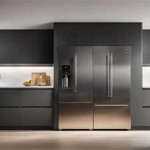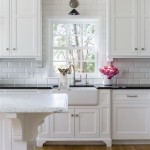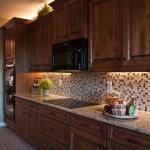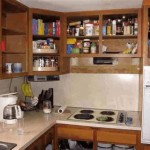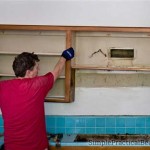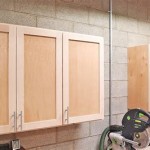Recessed Kitchen Cupboard Doors: A Detailed Exploration
Recessed kitchen cupboard doors, also known as inset doors, represent a sophisticated design choice that significantly impacts the aesthetic and functional aspects of a kitchen. Distinguished by their flush fit within the cupboard frame, creating a seamless, integrated appearance, recessed doors offer a unique alternative to traditional overlay designs. This article will delve into the nuances of recessed kitchen cupboard doors, examining their construction, design considerations, advantages, disadvantages, and installation aspects.
Understanding Recessed Door Construction
The defining characteristic of recessed doors lies in their construction and the meticulous attention to detail required for proper execution. Unlike overlay doors that sit on top of the cabinet frame, recessed doors are meticulously crafted to fit precisely within the frame's opening. This requires highly accurate measurements and skilled craftsmanship, as even slight discrepancies can compromise the overall aesthetic and functionality.
The construction process typically involves creating a cabinet frame with a perfectly square and level opening. The door itself must then be custom-made to match these dimensions, leaving a minimal gap for smooth operation without excessive friction. The hinges used for recessed doors are typically concealed, adding to the clean, minimalist look. These hinges are specifically designed to allow the door to swing smoothly within the frame without causing any obstruction.
Materials commonly used for recessed doors include solid wood, wood veneer, medium-density fiberboard (MDF), and plywood. Solid wood, particularly hardwoods like maple, cherry, and oak, offers durability and a premium look. Wood veneer provides the appearance of solid wood at a lower cost. MDF is often chosen for painted finishes due to its smooth, stable surface. Plywood offers a cost-effective and durable option, especially for larger door panels.
Design Considerations for Recessed Kitchen Cupboard Doors
Implementing recessed doors in a kitchen design involves careful consideration of several factors beyond mere aesthetics. The choice of door style, hardware, finish, and overall kitchen layout all contribute to the success of the design.
Door style options for recessed doors are vast, ranging from simple, flat panels to more elaborate designs with raised panels, beveled edges, or decorative molding. The chosen style should complement the overall kitchen design. A minimalist kitchen might benefit from flat panel doors, while a more traditional kitchen could incorporate raised panel doors with intricate details. Shaker-style doors, with their simple, clean lines, are a popular choice for recessed applications due to their versatility.
Hardware selection plays a crucial role in the overall aesthetic. Concealed hinges are almost always used to maintain the clean, flush appearance. Door pulls and knobs should be chosen to complement the door style and the kitchen's overall design theme. Options range from sleek, minimalist pulls in stainless steel or brushed nickel to more ornate knobs in antique brass or porcelain. The size and placement of the hardware should be carefully considered to ensure comfortable and ergonomic operation.
Finish options for recessed doors are extensive, including painted finishes, stained finishes, and natural wood finishes. Painted finishes are highly customizable and can be used to create a wide range of looks, from bright and modern to soft and traditional. Stained finishes enhance the natural beauty of wood grain and add warmth to the kitchen. Natural wood finishes showcase the raw beauty of the wood and are often paired with a clear coat for保护.
The kitchen layout should also be considered when incorporating recessed doors. Due to their inherent alignment with the cabinet frame, they can contribute to a more streamlined and organized appearance. In smaller kitchens, this can visually expand the space. However, in larger kitchens, the clean lines can enhance the overall sense of spaciousness and order.
Advantages and Disadvantages of Recessed Doors
Recessed kitchen cupboard doors offer several distinct advantages and disadvantages. A thorough understanding of these factors is critical for making an informed decision about incorporating them into a kitchen design.
One of the primary advantages is their aesthetic appeal. The flush, seamless look creates a clean, sophisticated, and high-end feel. This design choice elevates the overall appearance of the kitchen, making it appear more custom and well-crafted. The visual uniformity can also contribute to a more organized and uncluttered feel.
Another advantage is the precise alignment they offer. The flush fit minimizes gaps and unevenness, contributing to a more refined and polished appearance. This precision is particularly important in kitchens where aesthetics are a primary concern.
However, recessed doors also present certain disadvantages. One of the most significant is the higher cost compared to overlay doors. This is due to the increased labor and precision required for manufacturing and installation. Custom sizing and precise fitting contribute to the overall expense.
Installation can be more complex and time-consuming than with overlay doors. Accurate measurements and careful alignment are crucial for ensuring proper operation and visual appeal. Even slight errors can compromise the overall aesthetic and functionality, necessitating adjustments or even remanufacturing of the doors.
Maintenance can also be slightly more demanding. The tight fit can make it more susceptible to sticking or binding, especially in environments with fluctuating humidity levels. Minor adjustments may be required periodically to ensure smooth operation. The edges of the doors and frames are also more prone to wear and tear due to the constant friction, requiring occasional touch-ups or refinishing.
Furthermore, the reduced space within the cabinet box can be a consideration. The inset design effectively reduces the interior volume of the cabinet compared to overlay doors. While this difference is typically minimal, it can be a factor in smaller kitchens where storage space is at a premium.
The potential for exposure to environmental factors can also pose a challenge. Because the edges of the doors are more exposed, they are more susceptible to moisture damage and warping. This is particularly relevant in kitchens with high humidity levels or those prone to water spills. Selecting appropriate materials and finishes can help mitigate this risk.
Finally, accessibility can be marginally reduced, especially with certain hardware choices. The flush design can make it slightly more difficult to grip the edge of the door, particularly for individuals with limited dexterity. Choosing ergonomically designed hardware can help improve accessibility.
In summary, while recessed doors offer unparalleled aesthetic appeal and a sophisticated look, they also require a higher investment, more complex installation, and potentially more maintenance. Carefully weighing these advantages and disadvantages is essential for making an informed decision.

What Are Recessed Panel Cabinet Doors Nelson Cabinetry

What Are Recessed Panel Cabinet Doors Nelson Cabinetry

What Are Recessed Panel Cabinet Doors Nelson Cabinetry

Recessed Cabinet Doors Contemporary Kitchen Bhg

Diy Inset Cabinet Doors A Beginner S Way Remodelando La Casa

Recessed Flat Panel Cabinet Doors What Kitchen Style Is Good For Cabinets

Convert Stock Cabinets To Custom With Inset Doors Sincerely Marie Designs

What Is Recessed Panel Door Definition Of

Cabinet Door Styles 101 Shaker Raised Panels And More Vevano

How To Make Inset Kitchen Cabinets Diy
Related Posts

